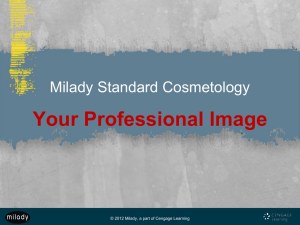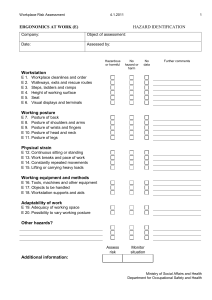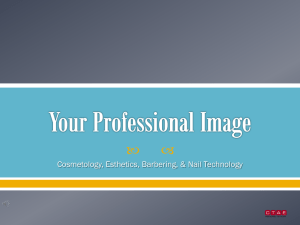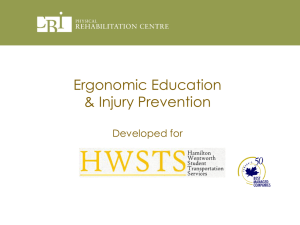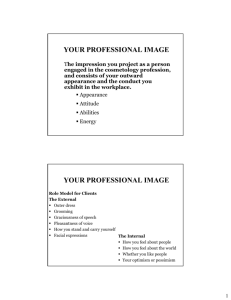Chapter 3 Your Professional Image Notes and review question
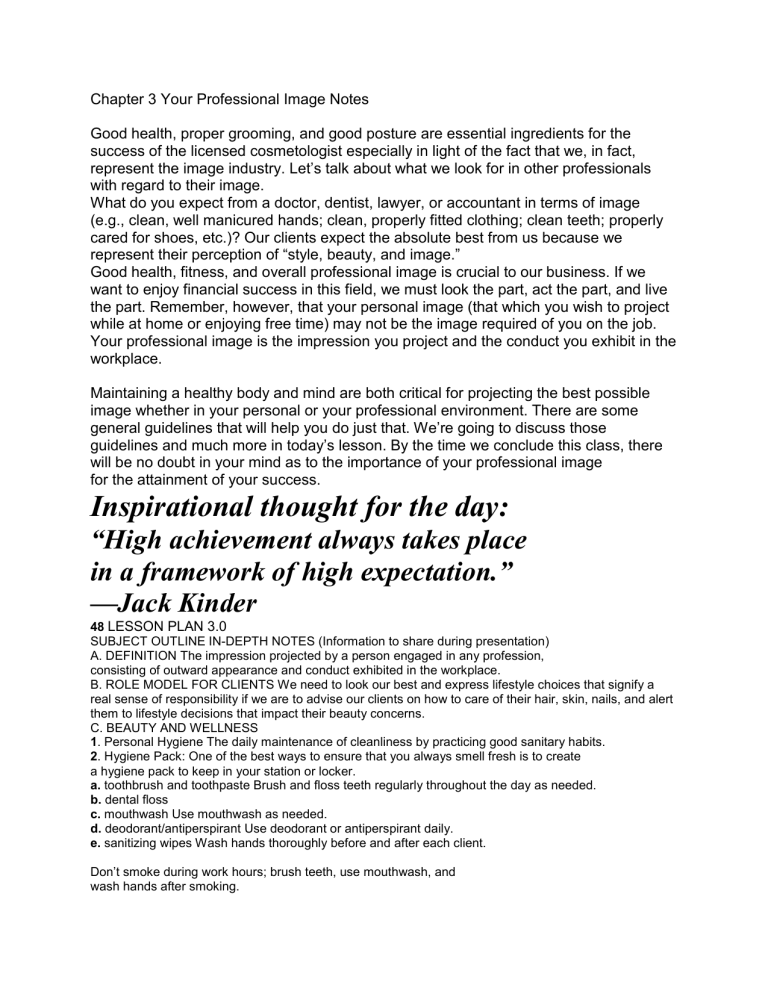
Chapter 3 Your Professional Image Notes
Good health, proper grooming, and good posture are essential ingredients for the success of the licensed cosmetologist especially in light of the fact that we, in fact, represent the image industry. Let’s talk about what we look for in other professionals with regard to their image.
What do you expect from a doctor, dentist, lawyer, or accountant in terms of image
(e.g., clean, well manicured hands; clean, properly fitted clothing; clean teeth; properly cared for shoes, etc.)? Our clients expect the absolute best from us because we represent their perception of “style, beauty, and image.”
Good health, fitness, and overall professional image is crucial to our business. If we want to enjoy financial success in this field, we must look the part, act the part, and live the part. Remember, however, that your personal image (that which you wish to project while at home or enjoying free time) may not be the image required of you on the job.
Your professional image is the impression you project and the conduct you exhibit in the workplace.
Maintaining a healthy body and mind are both critical for projecting the best possible image whether in your personal or your professional environment. There are some general guidelines that will help you do just that. We’re going to discuss those guidelines and much more in today’s lesson. By the time we conclude this class, there will be no doubt in your mind as to the importance of your professional image for the attainment of your success.
Inspirational thought for the day:
“High achievement always takes place in a framework of high expectation.”
—Jack Kinder
48 LESSON PLAN 3.0
SUBJECT OUTLINE IN-DEPTH NOTES (Information to share during presentation)
A. DEFINITION The impression projected by a person engaged in any profession, consisting of outward appearance and conduct exhibited in the workplace.
B. ROLE MODEL FOR CLIENTS We need to look our best and express lifestyle choices that signify a real sense of responsibility if we are to advise our clients on how to care of their hair, skin, nails, and alert them to lifestyle decisions that impact their beauty concerns.
C. BEAUTY AND WELLNESS
1 . Personal Hygiene The daily maintenance of cleanliness by practicing good sanitary habits.
2 . Hygiene Pack: One of the best ways to ensure that you always smell fresh is to create a hygiene pack to keep in your station or locker. a. toothbrush and toothpaste Brush and floss teeth regularly throughout the day as needed. b. dental floss c. mouthwash Use mouthwash as needed. d. deodorant/antiperspirant Use deodorant or antiperspirant daily. e. sanitizing wipes Wash hands thoroughly before and after each client.
Don’t smoke during work hours; brush teeth, use mouthwash, and wash hands after smoking.
3 . Looking Good a. Put thought into appearance b. Keep cut and color at best c. Keep skin well cared for d. Maintain nails e. Maintain trendy style
D. PERSONAL GROOMING
1 . Maintain wardrobe: a. clean, fresh, in step with fashion b. functional and stylish c. accessorize appropriately d. comfortable shoes Low-heeled, well-fitted with good support are best.
2 . The Art of Makeup a. Accentuate best features b. Minimize less flattering features Let the salon’s image be your guide on the right makeup choices to wear for work.
Remember, a professional image may not always allow for the kind of self-expression you are used to. The workplace requires some compromise between you and your employer. You must “tune in” to your salon’s energy and clientele to make choices that promote your career.
II. YOUR PHYSICAL PRESENTATION Is made up of your posture, walk, movements. In enhances or detracts from your attractiveness and is important to your well-being.
A. POSTURE
1 . Shows off figure.
2 . Can convey image of confidence.
3 . Can prevent fatigue.
4 . Can prevent other physical problems.
B. GUIDELINES FOR GOOD POSTURE
1 . Keep head up and chin parallel to floor.
2 . Keep neck elongated and balanced
directly above shoulders.
3 . Keep chest out and up, don’t slouch.
4 . Keep shoulders level and relaxed.
5 . Keep spine straight, not curved
6 . Keep abdomen flat.
7 . Keep hips level horizontally
8 . Flex knees slightly; position over feet. See Figure 3 –6.
C. ERGONOMICS DEFINITION:
1. An applied science concerned with designing and arranging things people use so that the people and things interact most efficiently and safely. — MerriamWebster’s 11th Collegiate Dictionary
2. The study of human characteristics for the specific work environment. Ergonomics attempts to “fit the job to the person,” and sometimes includes “human factors engineering.” — Safety and Health in the
Salon by Dennis Nelson
3. The study of how a workplace can best be designed for comfort, safety, efficiency, and productivity. It attempts to fit the job to the person. — Milady’s Standard Cosmetology
1 . MSDs Musculoskeletal disorders (MSDs) are muscle, bone, and joint disorders.
They include carpal tunnel syndrome and back injuries.
2 . Prevention is key. An awareness of body postures and movements, coupled with better
work habits and proper tools and equipment, will enhance your health and comfort.
3 . Self-Monitor Monitor yourself as you practice to see if you are doing any of these. a. Gripping too tightly b. Bending wrist constantly c. Holding arms away from body d. Holding elbows away from body e. Bending/twisting body To get closer to client. f. Inappropriate positioning of client on facial bed
4 . Preventive Measures a. Adjust chair height b. Keep wrists straight or neutral c. Don’t reach across table When giving manicure; have client reach across to you. d. Use ergonomically designed equipment e. Keep back and neck straight f. Use cushioned mat for standing
Your professional image is yours to create and define. Once you’ve identified the image you most want to project and have taken the steps to take ownership of it, your professional life will grow and flourish.
Through today’s lesson we have established that our professional image is comprised of much more than just our outer appearance. If we work in an environment that has any physical discomfort built into it, we need to try to counter the problem by including regular stretching intervals to break up the repetitiveness of the motions we use. It addition, we must put our health first and then the task at hand.
REVIEW QUESTIONS
1. List the elements of professional image.
ANSWER: Professional image is the impression projected by a person engaged in any profession, consisting of outward appearance and conduct exhibited in the workplace. Make sure your clothing is clean, fresh, and in step with fashion. Wear shoes that are comfortable and use makeup to accentuate your best features.
2. List three basic habits of personal hygiene.
ANSWER: Bathe or shower daily; Use deodorant or antiperspirant; Brush and floss teeth regularly
3. Identify what is included in a hygiene pack and where it is kept.
ANSWER: Toothbrush and toothpaste; Dental floss and mouthwash; Deodorant and/or antiperspirant;
Sanitizing hand wipes.
Keep your hygiene pack in your station or locker.
4. How often should you freshen up throughout the day?
ANSWER: Check periodically and refresh as often as needed.
5. List the general guidelines for dressing for success.
ANSWER: Maintain wardrobe: a. clean, fresh, in step with fashion b. functional and stylish c. accessorize appropriately d. comfortable shoes; low-heeled, well-fitted with good support are best.
6. What is the role of posture in good health?
ANSWER: Good posture helps prevent fatigue and other physical problems.
7. Assess your own standing posture and consider how it can be improved.
ANSWER: To be determined by each student.
8. Define the term ergonomics.
ANSWER: 1. An applied science concerned with designing and arranging things people use so that the people and things interact most efficiently and safely. — MerriamWebster’s 11th Collegiate Dictionary
2. The study of human characteristics for the specific work environm ent. Ergonomics attempts to “fit the job to the person,” and sometimes includes “human factors engineering.” — Safety and Health in the
Salon by Dennis Nelson
3. The study of how a workplace can best be designed for comfort, safety, efficiency, and productivity. It attempts to fit the job to the person. — Milady’s Standard Cosmetology
9. Give examples of ergonomically beneficial equipment.
ANSWER: Hydraulic chairs or manicure and facial stools that can be adjusted to accommodate different heights.
10. List steps you can take to prevent potential injury to yourself with regard to ergonomics.
ANSWER: Keep your wrists in a straight or neutral position. When giving a manicure, do not reach across the table; have the client extend her hand across the table to you. Use ergonomically designed implements. Keep your back and neck straight. Break up repetitiveness by including regular stretching intervals.
